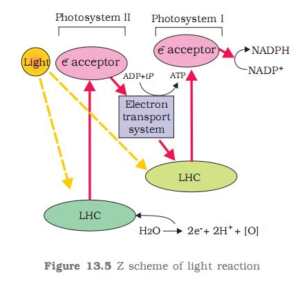Photosynthesis in Higher Plants MCQ/Objective questions Chapter 13 Biology
Which part of a plant takes part in photosynthesis?
- a. Green leaves
- b. White portion of a leaf
- c. Bark
- d. Root
A plant in which green stem photosynthesize is:
- a. Neem
- b. Ashoka
- c. Cactus
- d. Peepal
Which pigment a plant absorbs during photosynthesis?
- a. Infrared
- b. Ultraviolet
- c. Visible spectrum except green
- d. None
Coloured pigments other than chlorophyll is/are:
- a. Xanthophyll
- b. Carotenoid
- c. Lycopene
- d. All three
What is a light reaction?
- a. Formation of glucose
- b. Formation of sucrose
- c. Trapping of light in the form of ATP and NADPH
- d. None
Which part of the chloroplast takes part in light reaction?
- a. Membrane system
- b. Stroma lamellae
- c. Stroma
- d. None
During light react which molecule act as reaction centre?
- a. Light-harvesting complexes (LHC)
- b. PSI
- c. PSII
- d. Chlorophyll-a
Which among these have higher energy
- a. PSI
- b. PSII
- c. Both
- d. None
LHC upon excitation looses electron. Lost electron is replaced by:
- a. Splitting of carbon dioxide
- b. Splitting of Oxygen
- c. Splitting of water
- d. None
Which of the following factor will lower the rate of photosynthesis?
- a. High-intensity light
- b. High amount of water
- c. High amount of carbon dioxide
- d. Optimum temperature
There are two phase in photosynthesis one is light reaction and other is:

- a. Dark reaction
- b. Chemical decomposition
- c. Displacement reaction
- d. Oxidation
In which part of chloroplast dark reaction occur?
- a. Membrane system
- b. Stroma Lamella
- c. Stroma matrix
- d. Both b and c
Dark reaction is also called
- a. C3 cycle
- b. Calvin cycle
- c. CAM cycle
- d. Both a and b
Melvin Calvin used radioactive C14 to assese the dark reaction. Which plant did he use to study dark reaction?
- a. Algae
- b. Bryophytes
- c. Pteridophyte
- d. Angiosperm
The first product of a C3 cycle is:
- a. Acetic acid (2C)
- c. Puruvic acid (3C)
- c. Oxalo acetic acid (4C)
- d. Glucose (6C)
The primary acceptor of carbon dioxide is RuBisCO. How many carbon atoms does it have?
- a. 2C
- b. 3C
- c. 4C
- d. 5C
How many ATP’s and NADPH are required to form one glucose molecule in dark reaction?
- a. 6ATP, 6NADPH
- b. 12ATP, 12 NADPH
- c. 18ATP, 18NADPH
- d. None
In which plants c4 pathway occur?
- a. Mangrove
- b. Hydrophytes
- c. Succulents
- d. None
What is Kranz anatomy?
- a. Leaves with the bundle sheath
- b. Insect capturing leaves
- c. Leaf modified into a tendril
- d. None
Photorespiration is:
- a. RuBisCO interacting with O2 to form CO2
- b. RuBisCO interacting with CO2 to form PGA
- c. Pepco interacting with O2 to form CO2
- d. None
Which of the following is not a limiting factor for photosynthesis?
- a. Temperature
- b. O2 concentration
- c. CO2 concentration
- d. Light intensity
See also:
- The Living world MCQ
- Biological Classification MCQ
- Plant Kingdom MCQ
- Animal Kingdom MCQ Biology
- Morphology of Flowering Plants MCQ
- Anatomy of Flowering Plants MCQ
- Structural Organisation in Animals MCQ
- Cell The Unit of Life MCQ
- Transport in Plants MCQ
- Mineral Nutrition MCQ
Photosynthesis in Higher Plants MCQ/Objective questions Chapter 13 Biology
Ref: Chapter 13.